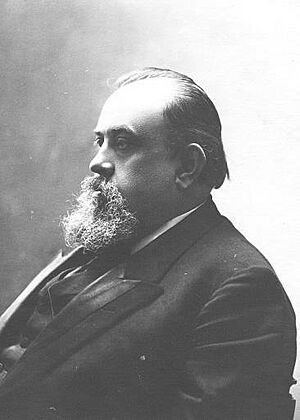Maksim Kovalevsky facts for kids
Maksim Maksimovich Kovalevsky (born September 8, 1851 – died April 5, 1916) was a very important Russian scholar. He was a jurist (someone who studies and practices law) and a leading expert in sociology (the study of how societies work). He was a top leader at the International Institute of Sociology and later became a member of the Russian Academy of Sciences. The Russian Sociological Society was even named after him.
Life of Maksim Kovalevsky
Maksim Kovalevsky grew up in a noble family near Kharkiv in Ukraine. He studied at the University of Kharkiv. To learn even more, he traveled to big cities like Berlin, Paris, and London. There, he met many famous thinkers of his time, including Karl Marx and Herbert Spencer. He also became involved in a social group called the Masonic movement in Russia.
After 1878, Kovalevsky taught law at the University of Moscow. He studied the Russian peasant commune, which were traditional village communities. He also looked at the legal systems of people in the Caucasus mountains. Some of his research was even used by Frederick Engels, another famous thinker. However, the government minister Ivan Delyanov did not like Kovalevsky's liberal ideas. Because of this, Kovalevsky left the university in 1886 and moved to Western Europe. There, he met many other important sociologists and anthropologists.
His cousin's wife, Sofia Kovalevskaya, who was a brilliant mathematician, helped him arrange lectures at the University of Stockholm. They were close friends and later parted ways in 1890. Sofia passed away the next year.
After the First Russian Revolution, Kovalevsky returned to Russia. He started teaching again at the University of Saint Petersburg. He also became involved in politics, helping to create a political party. He was elected to the first State Duma (a part of the Russian government) and later appointed to the State Council of the Russian Empire. In 1912, he was even nominated for a Nobel peace prize. He was planning to help with peace talks to end World War I, but he died in April 1916. Many people attended his funeral.
Kovalevsky and Freemasonry
Maksim Kovalevsky joined the Masonic movement in Paris in 1888. He was a member of the "Cosmos" lodge and later helped start the "Renaissance" lodge in 1906. He even became the leader, known as the Worshipful Master, of the "Renaissance" lodge.
Kovalevsky's Ideas
One of Kovalevsky's key contributions was a new way of studying history. He combined traditional ways of comparing different societies with methods used in sociology and anthropology. Some of his students, like Pitirim Sorokin, became famous sociologists themselves. His early work on peasant communities also influenced Georgy Plekhanov, another important Russian thinker.
As a scholar, Kovalevsky believed in social evolution. This is the idea that societies change and develop over time. He called himself a follower of Auguste Comte, a famous thinker who helped create the study of sociology. Kovalevsky defined sociology as "the science dealing with the organization and evolution of societies."
He strongly believed in progress, thinking it was a natural law of history. For him, progress meant that people would increasingly live together peacefully. This would expand from small tribal groups to entire nations, and eventually to a feeling of cosmopolitanism, where people see themselves as citizens of the whole world.
Kovalevsky thought that economic connections would grow stronger and stronger. He believed that more international trade would bring the whole world together economically. This would help prevent wars and eventually lead to a world where democratic countries worked together. He also thought that population growth was a main reason for this progress.
See also
- List of Russian legal historians
- Russian legal history


